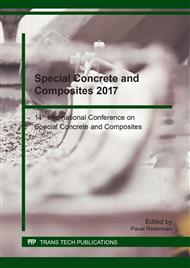p.22
p.30
p.37
p.43
p.49
p.55
p.61
p.67
p.73
Synthetic Preparation and Properties of Ettringite
Abstract:
This paper deals with the verification of the possibility of preparing synthetic ettringite in a way of direct addition of aluminum sulfate and calcium hydroxide as an alternative to the hydration of yeelimite. The stability of the resulting system was studied using the X-ray diffraction (XRD) and differential thermal analysis (DTA) in two different environments, namely in a laboratory environment and the environment of saturated water vapour. The evaluations of X-ray diffraction analysis and thermal analysis show that in the ettringite sample stored in the laboratory environment, evaporation of molecular water and subsequent transformation of ettringite into metaettringite or monosulfate can occur over time. Conversely, exposition of saturated water vapour environment can lead to saturation of the system by free calcium ions due to the slow dissociation of calcium carbonate, and thereby increase the amount of ettringite at the expense of gypsum and aluminum amorphous phase. To verify the above, it is recommended long-term monitoring of samples exposed in monitored environments.
Info:
Periodical:
Pages:
49-54
Citation:
Online since:
January 2018
Authors:
Price:
Сopyright:
© 2018 Trans Tech Publications Ltd. All Rights Reserved
Share:
Citation:


